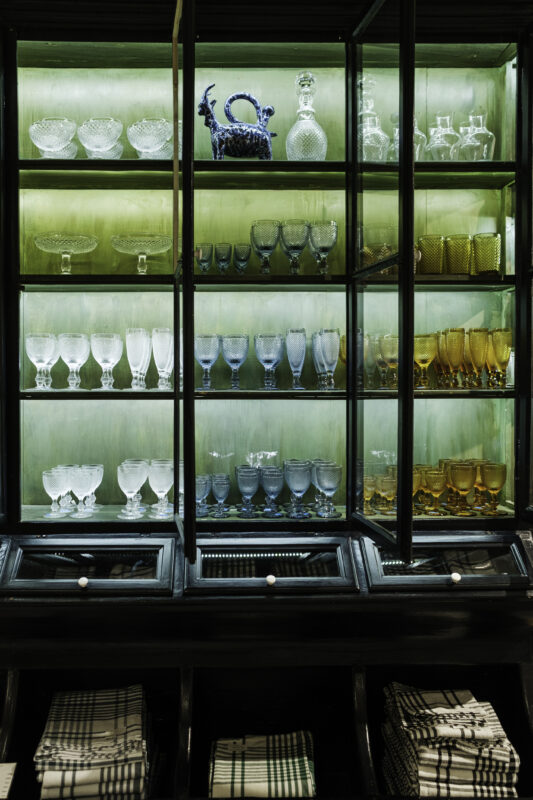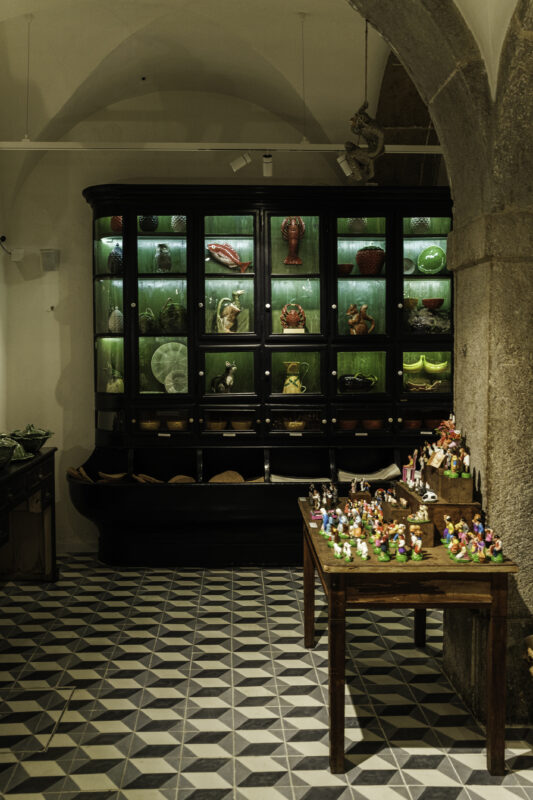A symphony of knots and fabrics: Vasco Águas narrates entire stories through his textile works. While his multi-layered composition in “Textile Landscapes” traces personal geographies, “Childhood Territories” reflects on his birthplace, childhood home and weekend escape – evoking the tactile intimacy of belonging through soft colours and flowing forms. Águas watched his grandfather melt lead sheets into fishing sinkers and admired his grandmother’s intricate embroidery. His fascination with haberdashery, ironmongery and DIY is closely linked to his childhood memories.
© Yago Barbosa
Which place do you currently call home and where do you work on your projects?
I consider myself very fortunate to have the opportunity to work close to my home. It only takes 20 minutes to walk from Campo de Ourique, a traditional and trendy neighbourhood, to Príncipe Real, another fashionable Lisbon neighbourhood, where the PR agency where I work is located.
Where is your studio located & how does it look?
Right now, my studio is nestled in my home, in a room I’ve completely dedicated to my creative work. It’s not a huge space, but it’s filled with beautiful natural light and has a cozy balcony that looks out onto a relatively quiet street. Because the room is compact, I’ve made the most of its high ceilings by installing floor-to-ceiling shelving units. They hold everything from fabrics and tools to my trusty sewing machine. Tucked among the materials are also some of my special objects — little treasures that carry personal meaning and spark creativity whenever I glance at them. One section of the shelving has even been transformed into a custom workstation, where I spend hours sketching, writing, and working on my computer. It’s a small space, but it’s mine — and every corner reflects the rhythm of my creative process.
© Francisco Nogueira
Are there any projects that are personally important to you – whether recently completed or currently in progress?
I’ve been working on some incredibly exciting projects — I’m glad you asked! Together with André Matos, I co-curated an exhibition called Crafting with AI, presented during Lisbon Design Week 2025. The show explored the relationship between AI tools and craftsmanship. It stemmed from André’s MA in New Media, in which he invited seven artists to create an artefact based on their exploration of an AI tool. Meanwhile, I was invited by Loulé Criativo to be the curator — and, in many ways, the coordinator — of a creative residency focused on the wool of the Churra Algarvia, a Portuguese sheep breed native to the Algarve, in southern Portugal. The group is fantastic, and we’ve been developing some amazing work that will be showcased this October at Loulé Criativo’s gallery. Still in the pipeline: a documentary about a creative residency André and I did in the Faroe Islands in 2024, several artworks for upcoming group exhibitions, and a whole 2026 to plan!
© Courtesy of the artist
© Arlindo Camacho
© Courtesy of the artist
Do you have a favourite place in your area where you like to relax and linger?
Sometimes I enjoy taking a simple walk to discover the neighbourhood, visiting galleries and small businesses. I love shopping for fresh produce such as fish, meat, and vegetables at the local market — Mercado de Campo de Ourique —, where I already have my favourite stalls. ‘Jardim da Estrela’ and ‘Tapada das Necessidades’ are also great spots to relax: two beautiful gardens on a walking distance where we can go with Roxy, our 10 year old Podengo, and stay the whole day by ourselves or on a picnic with friends.
One of my favorite spots is a bit further down by the Tagus river. It’s a beautiful riverside walk with incredible cultural landmarks, such as the MAAT museum, all within walking distance, which is perfect for getting some exercise.
© Hugo Ferreira, Tapada das Necessidades (7), CC BY-SA 4.0
Are there any urgent political issues or problems in your region?
In recent times, Portugal has been dealing with multiple political and societal crises that have significantly impacted the country’s stability. One of the most pressing issues is the emergence of far-right movements that promote extremist ideas. These movements have gained popularity and are posing a threat to the country’s democratic values and social cohesion.
In your opinion, what has developed well in the last 5 years – and what has not?
Over the last five years, there has been a significant surge in small creative businesses, which is a clear indication of the growing appreciation and demand for craftsmanship in different forms of artistic expression.
Fort the worse, it is worth noting that the process of gentrification in Lisbon has led to significant changes in certain neighbourhoods, including the rise in rental prices. This phenomenon has resulted in various consequences that have impacted the community as a whole.
Do you know a hidden gem when it comes to local manufacturers – whether it’s arts and crafts, sustainable products or food?
I know several all over the country, from weavers to woodworkers or ceramicists and it’s really hard to name just one. Because of its role in Portuguese tile history, I must recommend Viúva Lamego, a renowned tile maker that has been in operation for almost two centuries. The company is known for its exceptional craftsmanship and attention to detail when it comes to creating beautiful tiles. Viúva Lamego has also established itself as a hub for artistic development, attracting and nurturing talented artists who are passionate about this craft. The company’s commitment to excellence has earned it a reputation as one of the best places in the world to discover and appreciate the art of tile making.
“To tell the history of Viúva Lamego is to tell the history of Portuguese tile.“
Is there anything particularly innovative in your region? Also in comparison to other places you have already visited?
I cannot think of anything particularly innovative in my city or region. However, I would like to highlight the non-profit organization, Passa ao Futuro. Their mission is to preserve, promote, innovate, activate, and celebrate the Portuguese artisan sector through various initiatives, utilizing design thinking. They aim to support a socially, economically, and environmentally sustainable and responsible design process, business model, and future.
© TravelPhotosNL, View over the river Tagus, Lisbon, Portugal, CC BY-SA 4.0
© Francisco Anzola from United States, Torre de Belém (32583041007), CC BY 2.0
Do you have a secret restaurant tip that you would like to share with us?
I highly recommend Ciclo, a recently opened, family-run restaurant that emphasizes the importance of seasonal, local produce and works directly with small producers.
Is there a local shop whose products are only available in your region?
I must say that A Vida Portuguesa is not a new project, but it is worth mentioning. The project was created to maintain an inventory of Portuguese brands that have survived the test of time, to showcase the quality of Portuguese manufacturing, and to present Portugal in a unique way.
© Loja Nova Do Almada
© Loja Nova Do Almada
What are your 3 favourite apps that you use every day and couldn’t live without?
In no specific order: Instagram, Podcasts and WhatsApp.
Do you have any favourite newspapers or online magazines? And how do you keep up to date with politics or social and cultural issues?
I am careful about what I read and where I get my information from. Even though I prefer print media, I cannot ignore the convenience of staying informed about the world through online sources. Some of my go-to newspapers and magazines, to name just a few, include Observador, Expresso, and Público in Portugal, and internationally, I often read The New York Times, AD, and Yellowtrace.
©Susanne Nilsson, Castelo de São Jorge (34140503584), CC BY-SA 2.0
Imagine you could be mayor for a year – what would you change?
As I mentioned before, it is becoming increasingly difficult for ordinary people to afford to buy or rent a home, especially when compared to their income. I guess my main goal would be to work towards creating a more equitable and affordable housing market that would benefit all individuals, regardless of their financial situation.
One last question: If you could choose another place to live – regardless of financial or time constrains – which one would you choose?
I would go back to the Algarve, the region where I was born, probably between Lagos and Odeceixe. Or somewhere in Alentejo.













